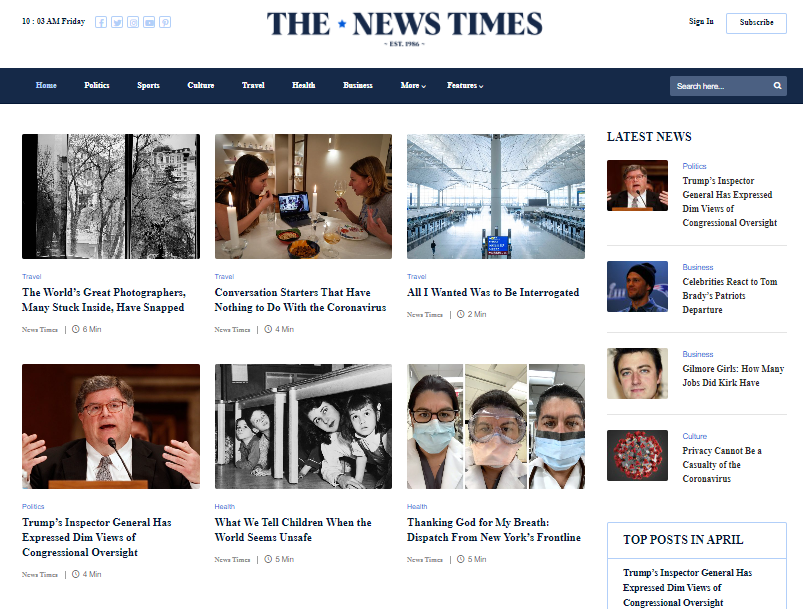Stnews.live: Avoid These Common Mistakes
The Influence of Social Network en route We Consume News Online
Social network has fundamentally changed news consumption. It gives prompt accessibility to details, typically eclipsing typical media outlets. However, this quick dissemination includes challenges. Users face the risk of coming across misinformation and ending up being entraped in echo chambers. The formulas driving customized material can cover diverse viewpoints. As these dynamics develop, understanding their ramifications becomes important for notified engagement in public discourse. What techniques might assist navigate this complicated landscape?
The Evolution of News Usage in the Digital Age
As modern technology progressed, the way people eaten news transformed considerably in the digital age (stnews.live). Conventional papers and broadcast media started to decrease as the web became a main source of information. On-line platforms used instant access to newspaper article, video clips, and podcasts, allowing individuals to stay educated at any moment. The benefit of mobile phones additionally accelerated this change, making it possible for customers to get updates on the move
Additionally, the increase of news aggregators and internet sites helped with the intake of varied perspectives, empowering customers to tailor their news consumption based upon individual interests. This advancement additionally prompted wire service to adjust their methods, focusing on electronic material and appealing viewers with multimedia formats. As a result, the conventional obstacles of time and room in news delivery reduced, resulting in a more instant and individualized news experience for target markets worldwide.
The Function of Social Network Operatings Systems in News Circulation
Social media systems have actually changed news circulation by supplying instantaneous accessibility to details. Their algorithm-driven material curation frequently prioritizes involvement over accuracy, bring about significant reputation obstacles (stnews.live). As users navigate this landscape, the ramifications for news consumption and public discourse come to be increasingly complicated
Immediate News Gain Access To
Although traditional news electrical outlets have long been the key source of details, the rise of social media sites platforms has dramatically changed just how news is accessed and consumed. Immediate news access has become a trademark of the digital age, allowing users to receive updates in actual time. Systems such as Twitter, Facebook, and Instagram enable news to spread quickly, often exceeding traditional media in speed and reach. Individuals can share stories, talk about events, and involve with reporters, producing a dynamic communication in between the target market and news web content. This immediacy cultivates a culture of seriousness, triggering users to inquire promptly. The assumption for prompt news has improved journalistic techniques, engaging news companies to adapt their strategies to meet the needs of a fast-paced electronic environment.
Algorithm-Driven Web content
While individuals actively engage with material on social media sites, the algorithms that govern these platforms play a pivotal function in establishing which newspaper article get presence. These formulas analyze customer behavior, choices, and involvement metrics to curate individualized news feeds. As a result, certain tales may be amplified while others stay unknown, typically focusing on mind-blowing or trending subjects over substantive reporting. This careful exposure forms customers' understandings of existing occasions and influences public discourse. In addition, the dependence on algorithm-driven content can create echo chambers, where customers are primarily revealed to point of views that straighten with their own ideas. The dynamics of news circulation on social media systems considerably affect how people take in and interpret details in the digital age.
Reputation Challenges
As users significantly transform to social media for news, the credibility of information experienced on these platforms ends up being a pressing worry. The decentralized nature of social media permits any person to publish content, frequently obscuring the lines between reputable journalism and false information. Algorithms focus on engagement over precision, resulting in the widespread circulation of mind-blowing or deceptive tales. This atmosphere presents significant challenges for individuals attempting to discern trustworthy resources. Social media site platforms, while striving to battle false information through fact-checking and material moderation, face objection for disparities and predispositions in their strategies. Eventually, the obligation lies with users to critically evaluate the news they take in, as the rapid spread of info commonly outmatches verification efforts by platforms.
The Increase of Citizen Journalism and User-Generated Material
The surge of resident journalism has actually empowered daily individuals to share news and viewpoints, commonly offering understandings that typical media might forget. Nevertheless, this change additionally offers considerable challenges, especially the spread of false information that can occur from unproven content. As user-generated web content becomes much more common, the balance in between authentic voices and precision in coverage stays a vital concern.
Empowering Everyday Voices

Difficulties of Misinformation
While the rise of citizen journalism has opened opportunities for diverse voices in the media landscape, it has likewise presented substantial challenges connected to false information. The convenience of sharing information through social media sites platforms allows people to distribute news swiftly, yet this quick spread frequently comes at the price of accuracy. User-generated content often lacks the strenuous fact-checking and content oversight that traditional journalism supplies. Subsequently, sensationalized or false narratives can gain traction, misdirecting audiences and shaping public understanding (stnews.live). The blending of viewpoint and reality within social media complicates the difference in between trustworthy information and false information. Therefore, consumers must navigate an increasingly complicated media environment, requiring vital thinking skills to recognize trusted news sources in the middle of the noise

Misinformation and Its Effects for Public Discourse
As social media systems significantly dominate the landscape of info circulation, the expansion of misinformation positions significant difficulties for public discussion. Misinformation, usually designed to misinform or provoke emotional actions, can distort understandings of fact and threaten trust in trustworthy resources. This sensation leads to polarized perspectives, as people gravitate towards resemble chambers that reinforce their beliefs, better entrenching divisions within culture.
The effects for public discussion are extensive. When residents rely upon false info, significant discussion diminishes, and the democratic process suffers. False information can prompt concern and confusion, impacting public health, safety, and political stability. Consequently, fostering media literacy comes to be vital, equipping people to critically examine info and discern truth from fiction. Attending to the difficulties postured by misinformation is essential for protecting the integrity of public discourse and ensuring an educated population with the ability of taking part in useful conversations.
The Influence of Algorithms on News Presence
Offered the main function of algorithms in determining material exposure, their influence on news consumption is extensive. These formulas, used by social media platforms, focus on certain kinds of content based on user interaction and preferences. Therefore, news articles that align with popular patterns or audience rate of interests are more most likely to be shown prominently, while much less astonishing stories might be forgotten. This creates an environment where individuals are exposed largely to info that reinforces their point of views, potentially leading to resemble chambers.
The consistent evolution of formulas means that news companies have to adjust their strategies to line up with these transforming criteria, frequently focusing on clickbait or psychologically charged headlines. As a result, the integrity of news reporting can be endangered, as crucial tales might not receive the exposure they deserve. The mathematical shaping of news visibility for that reason plays an essential function in influencing public understanding and understanding of present events.
The Shift Toward Aesthetic Storytelling in News Media
Significantly, news media is embracing visual narration as an effective device to involve target markets. This approach leverages pictures, video clips, infographics, and interactive elements to share details much more properly than typical text-based formats. As attention extends shorten, visuals offer a fast, impactful means to communicate complex tales and order viewers' interest.
Systems like Instagram and TikTok have further accelerated this fad, compelling news organizations to adjust their web content techniques to fit these visually-driven environments. By incorporating engaging visuals, news electrical outlets can boost psychological connections and foster greater understanding helpful resources of topical problems.
Visual storytelling permits for more diverse stories, showcasing multiple point of views through vibrant presentations. As target markets progressively consume news via mobile phones, the change toward visuals not just accommodates customer preferences however also aids to damage down obstacles to information access. Eventually, this evolution reflects a more comprehensive makeover in just how news is generated and consumed in the digital age.
Future Fads: Navigating the Transforming Landscape of News Intake
While the digital landscape continues to develop, news usage is positioned for considerable improvement driven by emerging innovations and transforming audience habits. As expert system and artificial intelligence advance, individualized news feeds will end up being extra prevalent, enabling customers to receive material customized to their passions. This modification can cause greater engagement however additionally raise worries about echo chambers and false information.
Moreover, the increase of voice-activated tools and wise audio speakers will certainly influence exactly how news is provided, changing the focus from visual to acoustic formats. This trend may encourage news organizations to embrace more concise and appealing audio material.

Regularly Asked Concerns
Exactly How Do Social Media Interactions Affect News Integrity?
Social network interactions can greatly affect understandings of news credibility. Engagement metrics, such as likes and shares, often form audience trust fund, with prominent messages obtaining regarded legitimacy, no matter the precision or reliability of the info presented.
What Duty Do Influencers Play in Shaping News Narratives?
Influencers significantly form news narratives by leveraging their systems to magnify certain tales, frequently customizing content to their target market. This can lead to biased point of views, impacting public understanding and focusing on sensationalism over accurate coverage.
How Can Users Identify Reliable News Sources on Social Media Site?
Users can recognize trustworthy news sources on social networks by examining the source's integrity, verifying check my site truths through numerous outlets, reviewing the expertise of the content, and recognizing prospective prejudices in reporting to guarantee accurate information.
What Effect Does Social Media Have on Conventional Journalism Jobs?
Social network considerably impacts typical journalism work by altering income designs, lowering need for print media, and promoting competitors from citizen journalists. Consequently, many professionals encounter job instability and must adjust to quickly transforming media landscapes.
Exactly How Do Different Demographics Consume News on Social Media?
Different demographics exhibit varied preferences for news intake on social media. Younger target markets prefer systems like TikTok and Instagram for fast updates, while older people often tend to prefer Facebook and Twitter for a lot more extensive discussions and articles.